2017 Peugeot 3008 Hybrid 4 battery
[x] Cancel search: batteryPage 72 of 578
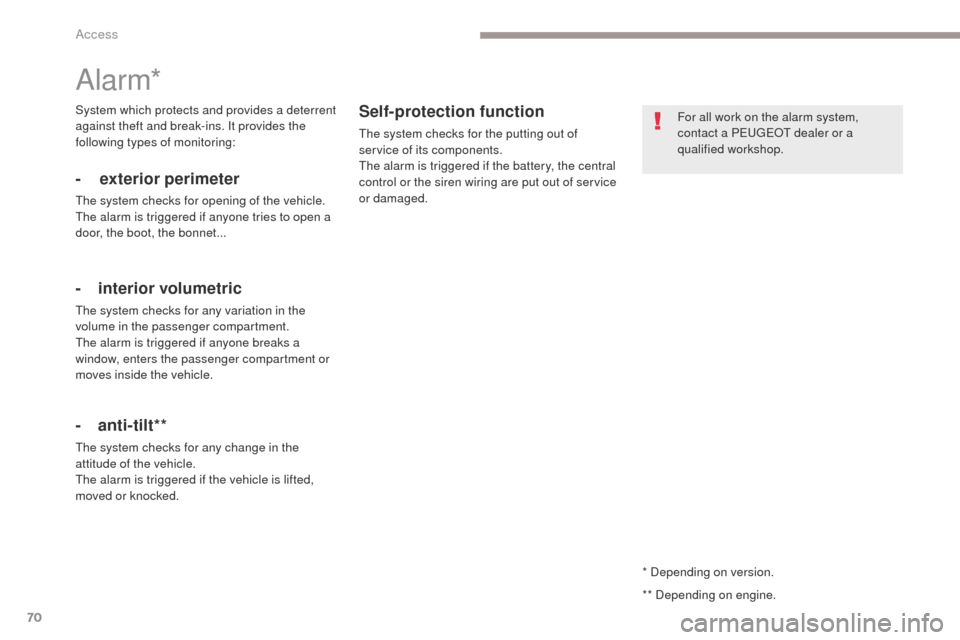
70
3008-2_en_Chap02_ouvertures_ed01-2016
* Depending on version.
Alarm*
- exterior perimeter
The system checks for opening of the vehicle.
The alarm is triggered if anyone tries to open a
door, the boot, the bonnet...
- interior volumetric
The system checks for any variation in the
volume in the passenger compartment.
The alarm is triggered if anyone breaks a
window, enters the passenger compartment or
moves inside the vehicle.
- anti-tilt**
The system checks for any change in the
attitude of the vehicle.
The alarm is triggered if the vehicle is lifted,
moved or knocked.
Self-protection function
The system checks for the putting out of
service of its components.
The alarm is triggered if the battery, the central
control or the siren wiring are put out of service
or damaged. For all work on the alarm system,
contact a PEUGEOT dealer or a
qualified workshop.
** Depending on engine.
System which protects and provides a deterrent
against theft and break-ins. It provides the
following types of monitoring:
Access
Page 82 of 578

80
3008-2_en_Chap02_ouvertures_ed01-2016
Precautions in use
In wintry conditions
In the event of an accumulation of snow
on the tailgate, clear the snow before
commanding a motorised opening of
the tailgate.
The formation of ice can block the
tailgate and prevent its opening: wait
until the ice melts with the heating of
the passenger compartment.
When washing
When washing the vehicle in an
automatic car wash, don't forget to
lock your vehicle to avoid the risk of
unexpected opening.
Reinitialising the motorised
tailgate
This operation is necessary where there is
no movement - after detection of an obstacle,
connecting or recharging the battery, ...
F
O
pen the tailgate manually, if necessary.
F
F
ully close the tailgate manually.
If the problem persists, contact a PEUGEOT
dealer or a qualified workshop.
Access
Page 83 of 578
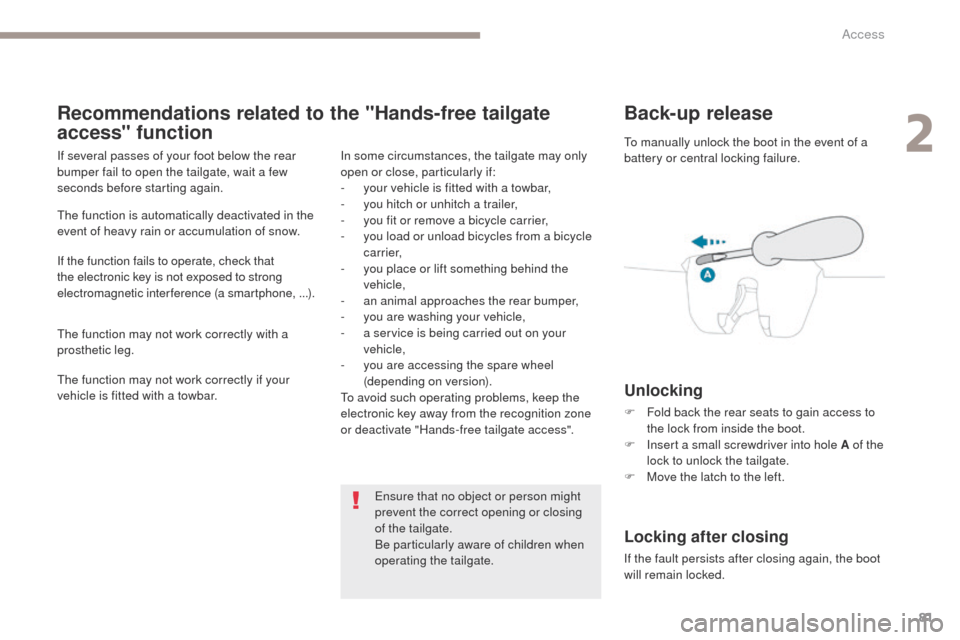
81
3008-2_en_Chap02_ouvertures_ed01-2016
Back-up release
Unlocking
F Fold back the rear seats to gain access to the lock from inside the boot.
F
I
nsert a small screwdriver into hole A of the
lock to unlock the tailgate.
F
M
ove the latch to the left.
Locking after closing
If the fault persists after closing again, the boot
will remain locked. To manually unlock the boot in the event of a
battery or central locking failure.
Recommendations related to the "Hands-free tailgate
access" function
If several passes of your foot below the rear
bumper fail to open the tailgate, wait a few
seconds before starting again.
The function is automatically deactivated in the
event of heavy rain or accumulation of snow.
If the function fails to operate, check that
the electronic key is not exposed to strong
electromagnetic interference (a smartphone, ...).
The function may not work correctly with a
prosthetic leg.
The function may not work correctly if your
vehicle is fitted with a towbar. In some circumstances, the tailgate may only
open or close, particularly if:
-
y
our vehicle is fitted with a towbar,
-
y
ou hitch or unhitch a trailer,
-
y
ou fit or remove a bicycle carrier,
-
y
ou load or unload bicycles from a bicycle
c a r r i e r,
-
y
ou place or lift something behind the
vehicle,
-
an
animal approaches the rear bumper,
-
y
ou are washing your vehicle,
-
a s
ervice is being carried out on your
vehicle,
-
y
ou are accessing the spare wheel
(depending on version).
To avoid such operating problems, keep the
electronic key away from the recognition zone
or deactivate "Hands-free tailgate access".
Ensure that no object or person might
prevent the correct opening or closing
of the tailgate.
Be particularly aware of children when
operating the tailgate.
2
Access
Page 85 of 578
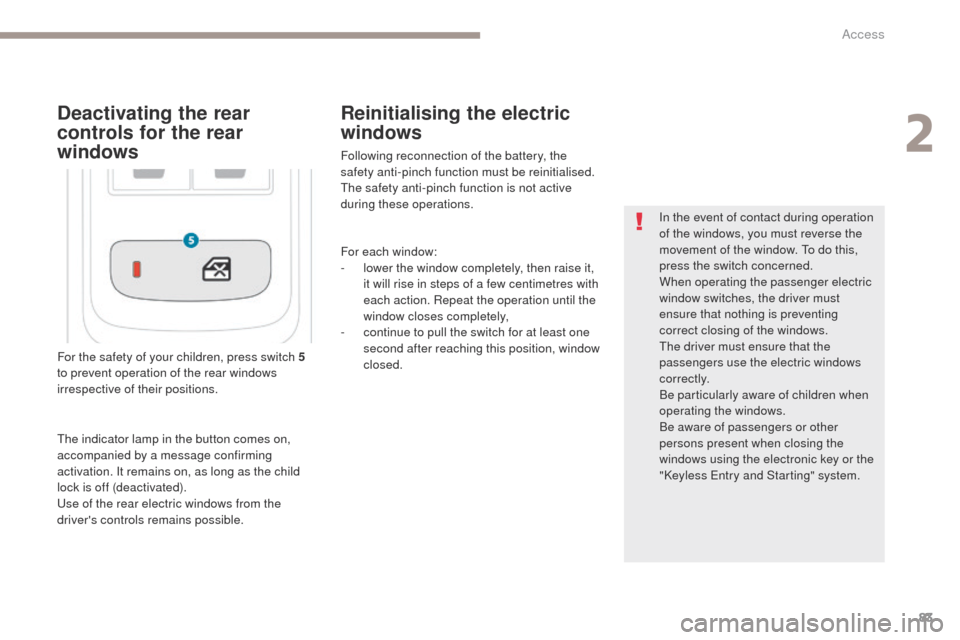
83
3008-2_en_Chap02_ouvertures_ed01-2016
For the safety of your children, press switch 5
t o prevent operation of the rear windows
irrespective of their positions. In the event of contact during operation
of the windows, you must reverse the
movement of the window. To do this,
press the switch concerned.
When operating the passenger electric
window switches, the driver must
ensure that nothing is preventing
correct closing of the windows.
The driver must ensure that the
passengers use the electric windows
c o r r e c t l y.
Be particularly aware of children when
operating the windows.
Be aware of passengers or other
persons present when closing the
windows using the electronic key or the
"Keyless Entry and Starting" system.
Deactivating the rear
controls for the rear
windows
The indicator lamp in the button comes on,
accompanied by a message confirming
activation. It remains on, as long as the child
lock is off (deactivated).
Use of the rear electric windows from the
driver's controls remains possible.
Reinitialising the electric
windows
Following reconnection of the battery, the
safety anti-pinch function must be reinitialised.
The safety anti-pinch function is not active
during these operations.
For each window:
-
l
ower the window completely, then raise it,
it will rise in steps of a few centimetres with
each action. Repeat the operation until the
window closes completely,
-
c
ontinue to pull the switch for at least one
second after reaching this position, window
closed.
2
Access
Page 86 of 578
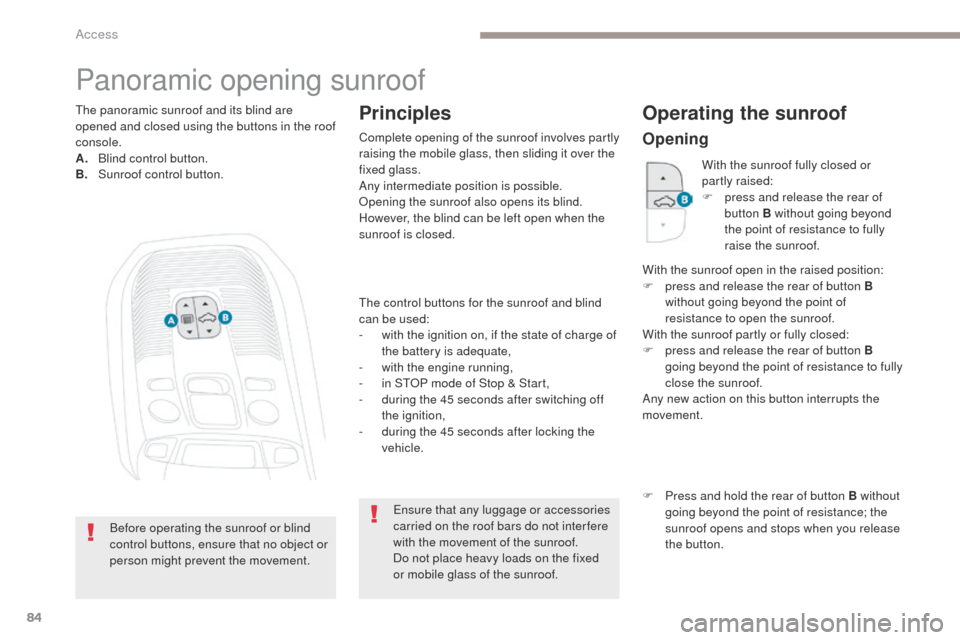
84
3008-2_en_Chap02_ouvertures_ed01-2016
Panoramic opening sunroof
The control buttons for the sunroof and blind
can be used:
-
w
ith the ignition on, if the state of charge of
the battery is adequate,
-
w
ith the engine running,
-
i
n STOP mode of Stop & Start,
-
d
uring the 45 seconds after switching off
the ignition,
-
d
uring the 45 seconds after locking the
vehicle.
Opening
The panoramic sunroof and its blind are
opened and closed using the buttons in the roof
console.
A.
B
lind control button.
B.
S
unroof control button.
Ensure that any luggage or accessories
carried on the roof bars do not inter fere
with the movement of the sunroof.
Do not place heavy loads on the fixed
or mobile glass of the sunroof.
Before operating the sunroof or blind
control buttons, ensure that no object or
person might prevent the movement.Principles
Complete opening of the sunroof involves partly
raising the mobile glass, then sliding it over the
fixed glass.
Any intermediate position is possible.
Opening the sunroof also opens its blind.
However, the blind can be left open when the
sunroof is closed. With the sunroof fully closed or
partly raised:
F
p
ress and release the rear of
button B without going beyond
the point of resistance to fully
raise the sunroof.
With the sunroof open in the raised position:
F
p
ress and release the rear of button B
without going beyond the point of
resistance to open the sunroof.
With the sunroof partly or fully closed:
F
p
ress and release the rear of button B
going beyond the point of resistance to fully
close the sunroof.
Any new action on this button interrupts the
movement.
Operating the sunroof
F Press and hold the rear of button B without going beyond the point of resistance; the
sunroof opens and stops when you release
the button.
Access
Page 87 of 578
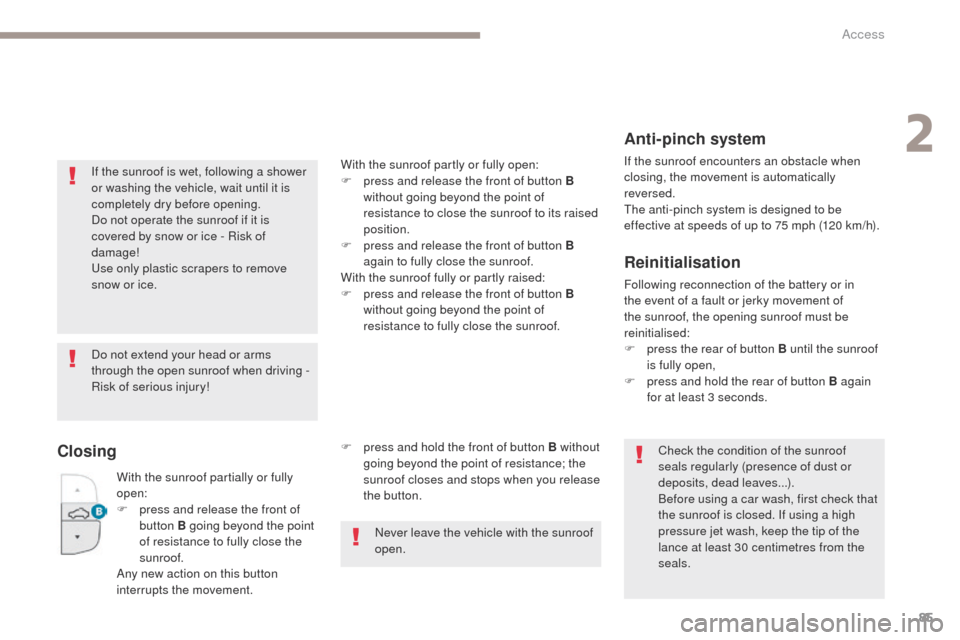
85
3008-2_en_Chap02_ouvertures_ed01-2016
If the sunroof is wet, following a shower
or washing the vehicle, wait until it is
completely dry before opening.
Do not operate the sunroof if it is
covered by snow or ice - Risk of
damage!
Use only plastic scrapers to remove
snow or ice.
Do not extend your head or arms
through the open sunroof when driving -
Risk of serious injury!
ClosingF press and hold the front of button B without going beyond the point of resistance; the
sunroof closes and stops when you release
the button.
Never leave the vehicle with the sunroof
open.
Anti-pinch system
If the sunroof encounters an obstacle when
closing, the movement is automatically
reversed.
The anti-pinch system is designed to be
effective at speeds of up to 75 mph (120 km/h).
Reinitialisation
Following reconnection of the battery or in
the event of a fault or jerky movement of
the sunroof, the opening sunroof must be
reinitialised:
F
p
ress the rear of button B until the sunroof
is fully open,
F
p
ress and hold the rear of button B again
for at least 3 seconds.
Check the condition of the sunroof
seals regularly (presence of dust or
deposits, dead leaves...).
Before using a car wash, first check that
the sunroof is closed. If using a high
pressure jet wash, keep the tip of the
lance at least 30 centimetres from the
seals.
With the sunroof partially or fully
open:
F
p
ress and release the front of
button B going beyond the point
of resistance to fully close the
sunroof.
Any new action on this button
interrupts the movement. With the sunroof partly or fully open:
F
p
ress and release the front of button
B
without going beyond the point of
resistance to close the sunroof to its raised
position.
F
p
ress and release the front of button B
again to fully close the sunroof.
With the sunroof fully or partly raised:
F
p
ress and release the front of button
B
without going beyond the point of
resistance to fully close the sunroof.
2
Access
Page 88 of 578
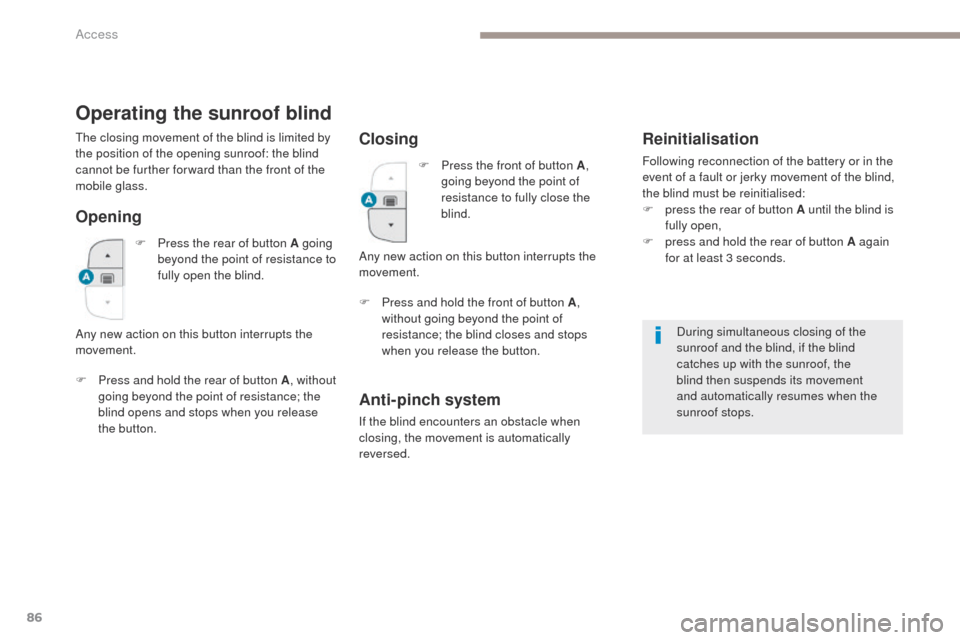
86
3008-2_en_Chap02_ouvertures_ed01-2016
Operating the sunroof blind
Opening
F Press and hold the rear of button A, without
going beyond the point of resistance; the
blind opens and stops when you release
the button. During simultaneous closing of the
sunroof and the blind, if the blind
catches up with the sunroof, the
blind then suspends its movement
and automatically resumes when the
sunroof stops.
The closing movement of the blind is limited by
the position of the opening sunroof: the blind
cannot be further for ward than the front of the
mobile glass.
Closing
Any new action on this button interrupts the
movement.
Anti-pinch system
If the blind encounters an obstacle when
closing, the movement is automatically
reversed.
Reinitialisation
Following reconnection of the battery or in the
event of a fault or jerky movement of the blind,
the blind must be reinitialised:
F
p
ress the rear of button A until the blind is
fully open,
F
p
ress and hold the rear of button A again
for at least 3 seconds.
F
P
ress the rear of button A going
beyond the point of resistance to
fully open the blind.
Any new action on this button interrupts the
movement. F
P
ress the front of button A ,
going beyond the point of
resistance to fully close the
blind.
F
P
ress and hold the front of button
A ,
without going beyond the point of
resistance; the blind closes and stops
when you release the button.
Access
Page 117 of 578

115
3008-2_en_Chap03_ergonomie-et-confort_ed01-2016
Mono-zone / Dual-zone
The passenger temperature setting can be
indexed to the driver's setting (mono-zone
function).
It is available in the secondary page by
pressing the "OPTIONS" button.
F
P
ress this button to activate the
" MONO " function; its " ON" status
is displayed.
The function is automatically deactivated if the
passenger uses their temperature adjustment
buttons (dual-zone function).
Ventilation with the ignition on
With the ignition on, you can use the ventilation
system, controlling the air flow and distribution
in the passenger compartment.
This function is also available for a few minutes
after switching off the ignition, depending on
the state of charge of the vehicle's battery.
You can also make use of the residual
heat in the engine to warm the passenger
compartment, using the temperature
adjustment buttons.
This function does not activate operation of the
air conditioning.
Switching off the system
F Press this button; its indicator lamp comes on and all other indicator
lamps for the system go off.
This action deactivates all functions of the air
conditioning system.
Temperature is no longer regulated. A slight air
flow can still be felt however, resulting from the
for ward movement of the vehicle.
Avoid driving for long periods with
the system off - Risk of misting and
deterioration of air quality!
Pressing any button reactivates the
system with the settings that were
previously in use.
3
Ease of use and comfort